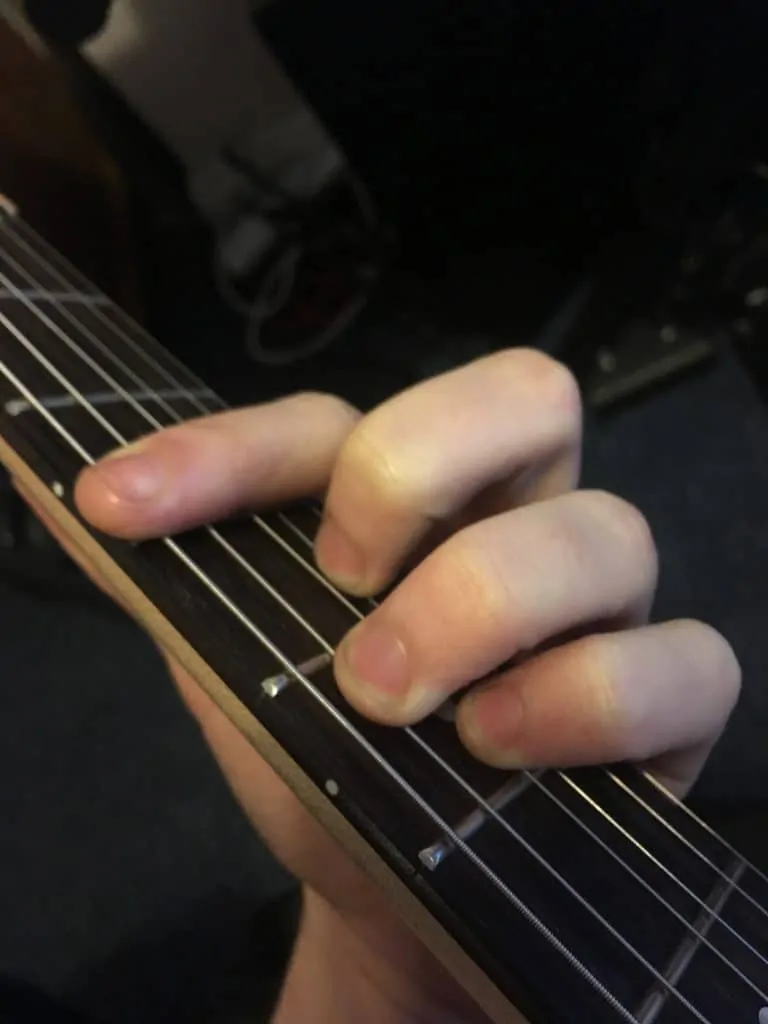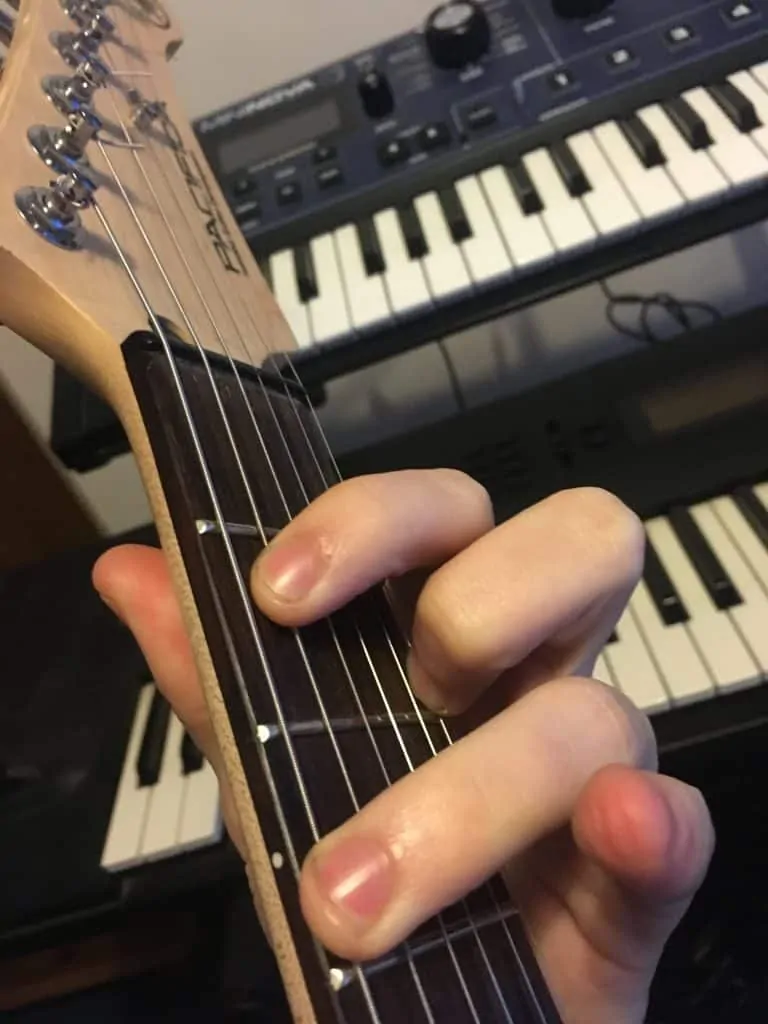There are a lot of chords you’ll come across while learning guitar, but few of them will crop as much as a simple G chord. We’ve done a lot of guides to how to approach playing chords through various techniques, and many different variations on these basic shapes. Maybe start by having a look at our guide to How To Play chords to get some basics down.
Contents
G Chord Guide
In this important guide, I’ll be taking you through a huge number of variants of the G chord:
If you’re looking for a place to start with G chords, then look no further…
G Major Chord
Every major scale has the same theory behind it, building on a pattern of tones between the notes: 1-1-1/2-1-1-1-1/2. On a piano, the ‘1’ means that if you’re starting on the C, then there will be one note (Db in this case) between your C and the next note of the scale (D), while the 1/2 means that the next note of the scale is directly next door (such as in the move from E-F in C major). Learn more about the C Chord here. On a guitar, the 1/2 means the next fret is in the scale, and the 1 means there will be a fret in between the two notes.
G major: G-A-B-C-D-E-F#
Each of these notes (degrees of the scale) can be assigned a number as it ascends so you can use a helpful formula to work out chords from it. The G is a 1, the A is a 2 etc.
Once you’re familiar with the scale, you’ll do well to remember that the formula for a G major chord (and any tonic major chord of any key) is 1-3-5 which gives the notes G-B-D.
Within the key of G major, you can make various chord sequences and work them out using this numbering system, but remember that G major is your tonic, and is where the key will sound resolved and at home.
Songs That Use G Major Chords
Of course, there is no genre that you’ll find a G major chord specifically. It’d be very rare to think about using a specific chord when writing a song, though thinking about the type of chord is a different story. Major chords give out a positive sound (though in a minor key context they can still hold sadness), so this gives them a versatile range, though you’ll rarely hear a standard G major chord in death metal!
- Pink Floyd- Wish You Were Here
- John Mayer- Gravity
- Nirvana- Come as You Are
- Passenger- Let Her Go
- Radiohead- Creep
- Queen- Another One Bites the Dust
- Metallica- Enter Sandman
- Eagles- Lyin’ Eyes
- The Beatles- Blackbird
- Lynyrd Skynyrd- Sweet Home Alabama
- Guns N’ Roses- Sweet Child O’ Mine
- Metallica- Nothing Else Matters
- Van Morrison- Brown Eyed Girl
- Green Day- Good Riddance (Time of Your Life)
- Jack Johnson- Banana Pancakes
Playing G Major
Variation 1
Okay, so now that you’re ready to play G major I can show you it in its basic form. This is the ‘open’ version of the chord, so you’ll be hitting open strings with this one so it allows you to avoid barring, which is great if you’re a beginner.
This chord works perfectly on acoustic guitar, but an electric guitar with overdrive may struggle to give it a clear sound.
You’ll want your 3rd finger on the 3rd fret of the 6th string, your 2nd finger on the 2nd fret of the 5th string, your 4th finger on the 3rd fret of the 2nd string and your 5th finger on the 3rd fret of the 1st string. Let the 3rd and 4th strings ring out when you play it.
Variation 2
This first variation is a barre chord on the 3rd fret. This is a nice alternative to the open version when playing on overdriven guitar, as it is still nice and low but you can mute and control each string.
Use your 2nd finger to barre across fret 3, then put your 4th finger on 5th fret of the 5th string, your 5th finger on the 5th fret of the 4th string and your 3rd finger on the 4th fret of the 3rd string.
Variation 3
This variation puts the chord into first inversion by putting the 3rd on the bottom. This changes the tone of the chord and allows you to use it in many different contexts.
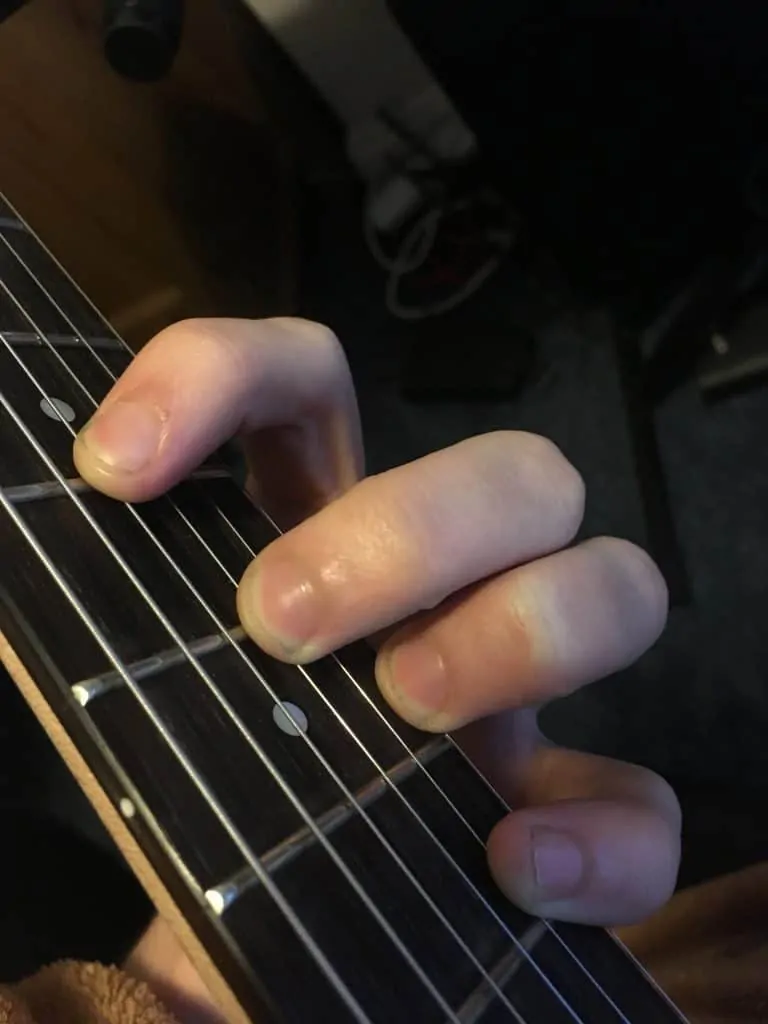
You’ll want to make sure the 5th and 6th strings are muted for this one. You’ll want your 2nd finger on the 5th fret of the 4th string, your 3rd finger on the 7th fret of the 3rd string, your 5th finger on the 8th fret of the 2nd string and your 4th finger on the 7th fret of the 1st string.
Variation 4
Finally, this high up variation of the chord is good for use in jazz styles, as it lends itself well to forceful, staccato playing. Although, it does include a bit of a complex squashing of your fingers onto quite a small fret, so it’ll take some practice.
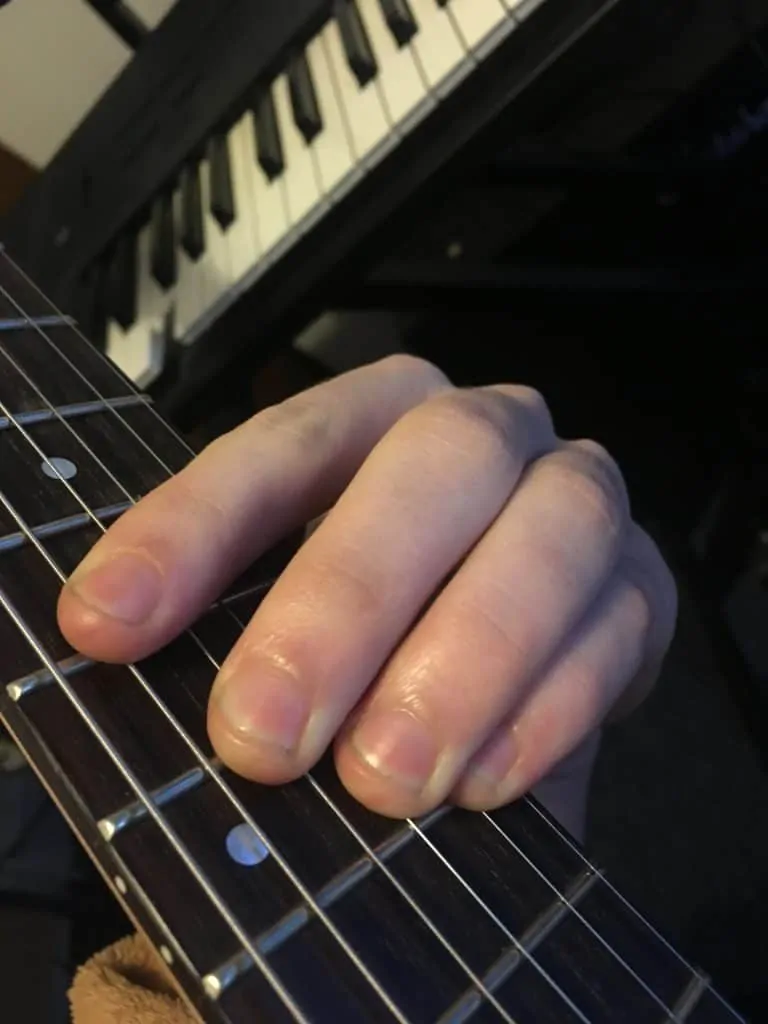
You’ll want to use your 2nd finger to barre the 10th fret, from the 5th to 1st strings- mute the 6th. Then your 3rd, 4th and 5th fingers will all need to find a way to squash into the 12th fret on strings 4, 3 and 2 respectively.
G Minor Chord
A minor scale differs slightly from a major scale in that degrees 3, 6 and 7 are all flattened, so they are lowered by one semitone. This creates the G natural minor scale (variants such as the harmonic and melodic minor will be looked at in a separate guide).
G minor: G-A-Bb-C-D-Eb-F
We could apply numbers to these much like we did with the major scale, so a G minor chord would still be 1-3-5, like the major. But this is a bit confusing, so let’s approach it from the context of the major scale.
A G minor chord is 1-b3-5, so therefore made up of the notes G-Bb-D.
Songs That Use G Minor
Again, rarely does a song seek to use the G note, but will look to use a type of chord in order to create a certain sound. A minor chord is a lot darker and sadder than a major chord, so it’ll appear in a lot of more atmospheric, sad music. Having said that, it can still have an uplifting sound when played in certain contexts.
- Santana- Evil Ways
- The Script- Hall Of Fame
- Adele- I Miss You
- Linkin Park- What I’ve Done
- Eminem- Love The Way You Lie
- Lukas Graham- 7 Years
- Pink Floyd- Shine On You Crazy Diamond
Playing G Minor
Variation 1
Unless you have superhuman hands, G minor doesn’t really have an open equivalent like G major. That means that its lowest and arguably simplest form is that of a barre chord, which makes it a hard chord but one that is versatile and able to be used in a huge number of genres.
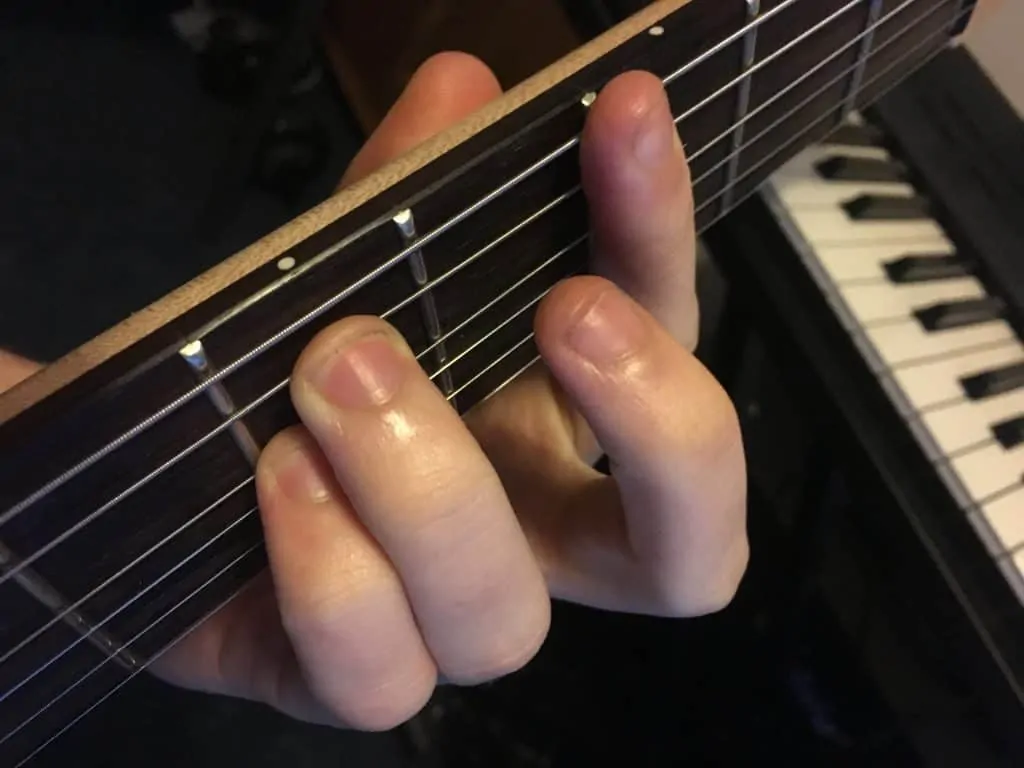
For this chord, you’ll need to barre the 3rd fret with your 2nd finger. From then, you’ll pretty much copy the major shape by putting your 4th finger onto the 5th fret of string 5 and your 5th finger on the 5th fret of the 4th string. Rather than adding your 3rd finger in, you’ll just need to make sure your barre allows for the minor 3rd (3rd fret of the 3rd string) to be heard and give the chord its distinctive quality.

Variation 2
The 5th fret alternative of the G minor chord requires you to spread 4 fingers across 4 different strings, so if you aren’t ready for big stretches then work up to this one.
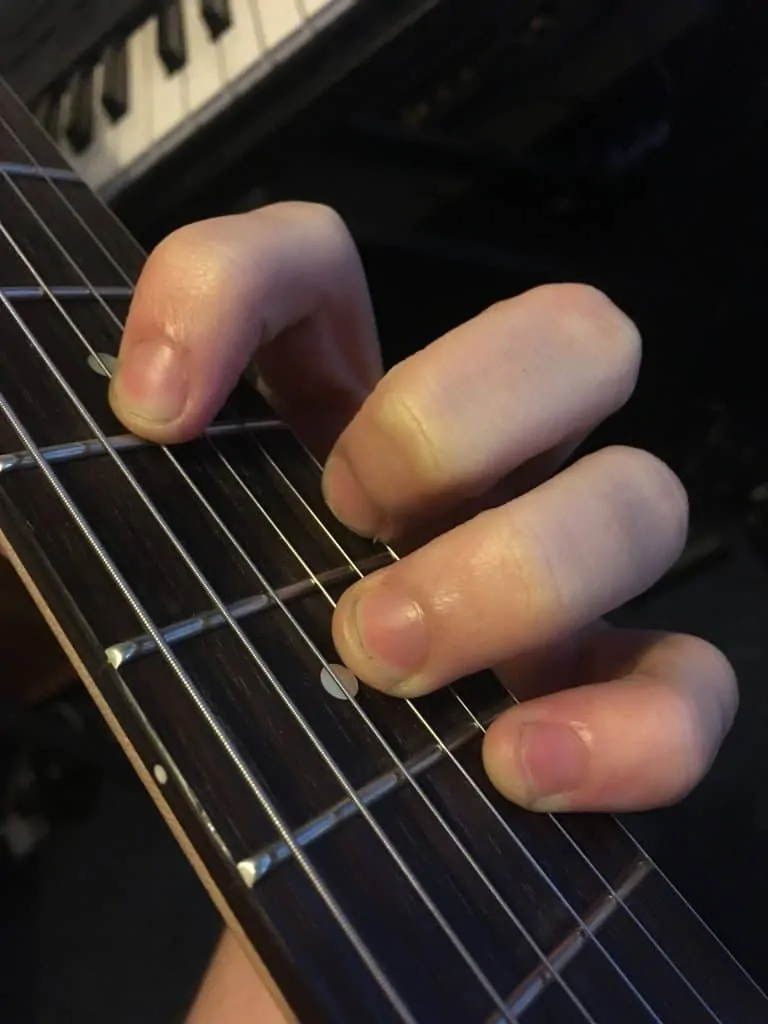
Your 2nd finger will be on the 5th fret of the 4th string, your 4th finger on the 7th fret, your 5th finger on the 8th fret of the 2nd string and your 3rd finger on the 6th fret of the 1st string.
Variation 3
This high up variation allows you to play the simple minor chord shape up on the 10th fret. Barre across the 10th fret with your 2nd finger from the 5th to 1st strings. Place your 4th finger on the 12th fret of the 4th string, your 5th finger on the 12th fret of the 3rd string and your 3rd finger on the 11th fret of the 2nd string.
G7 Chord
A G7 chord, or G dominant 7, is a major chord with an added minor 7th. This creates an interval of a tritone within the chord, adding a laying of dissonance to the sound. In a lot of music, the G7 is used as part of a perfect cadence, in order to resolve to the tonic. However, one of the primary uses of the dominant 7th in modern music, is as a part of jazzy chord sequences.
If we use major scale theory (which we would unless you’re delving into the realm of modality where this chord has a strong Mixolydian quality) then the formula for this chord is 1-3-5-b7. The b7 takes the F# of a G major scale down to a regular F.
This means that the notes in a G7 chord are G-B-D-F.
Songs That Use G7
While a G7 can be used in any context, this type of chord can be found in a huge amount of jazz due to its massively ‘jazzy’ nature. Contextually, this chord can give an air of unease due to the dissonant intervals within it, but at the same time can sound uplifting due its major 3rd.
- The Beatles- Get Back
- Miles Davis- All Blues
- Beach Boys- Fun Fun Fun
- Creedence Clearwater Revival- Down On The Water
- Hank Williams- Jambalaya
- Charlie Parker- Ornithology
- Benny Goodman- How High The Moon
Playing G7
Variation 1
Often, 7th chords don’t have open variations, but this is one of the rare exceptions to that rule. While it starts quite similarly to a G major chord, be aware that you’ll need to approach this one with quite a different hand shape.
Place your 4th finger on the 3rd fret of the 6th string, your 3rd finger on the 2nd fret of the 5th string and your 2nd finger on the 1st fret of the 1st string. Make sure you let the 3 open strings between ring out when you play this chord.
Variation 2
This one uses quite a nice, moveable dominant 7th shape that allows you to bring out each note, without barring or playing the bottom or top strings. If you’re familiar with an open C7 chord, then simply move it all the way up to start on the 10th fret rather than the 3rd
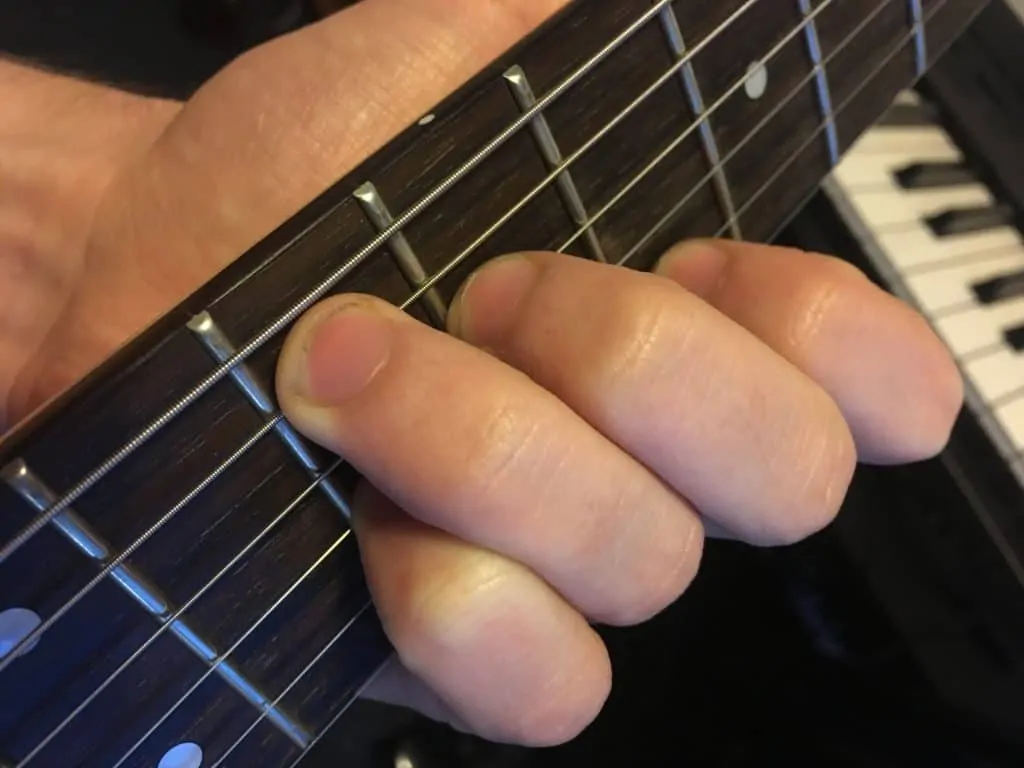
Have your 4th finger on the 10th fret of the 5th string, your 3rd finger on the 9th fret of the 4th string, your 5th finger on the 10th fret of the 3rd string and your 2nd finger on the 8th fret of the 2nd string. Make sure you mute both E strings when playing this chord.
Variation 3
This is probably the most common way of playing the G7 chord, but it does require a bit of finger strength in order to make the barre across the 3rd fret. However, it isn’t too hard to get into position so it’d be quite adept for use when playing acoustic music if you can pull off the barre.
Use your 2nd finger to barre across the 3rd fret, then press your 4th finger into the 5th fret of the 5th string and your 3rd finger into the 4th fret of the 3rd string. When playing, make sure the 6th string’s 3rd fret is pressed down properly as this is your bass note.
Variation 4
This simple, 3 note version of the chord is probably my favourite variation of the G7 chord. It is high up on the neck, requires very little stretching and the way it is so easy to pluck makes it the perfect way of voicing the chord when playing jazz.
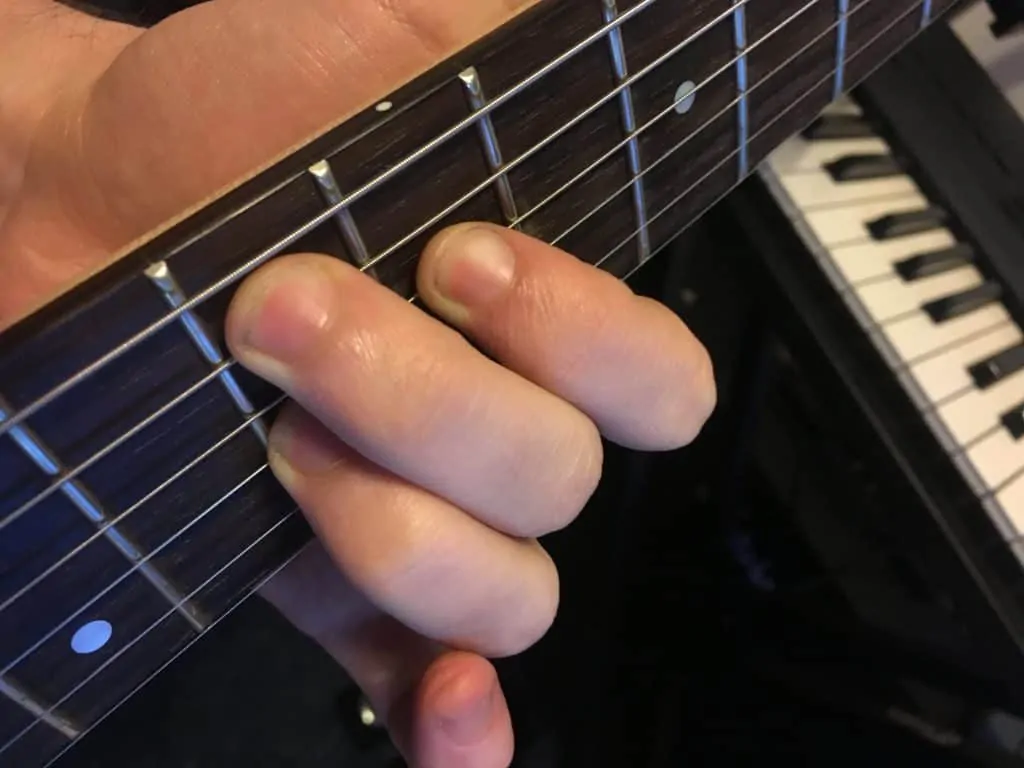

Mute all but strings 5, 4 and 3. Your 3rd finger will need to be on the 10th fret of the 5th string, your 2nd finger on the 9th fret of the 4th string and your 4th finger on the 10th fret of the 4th string.
Gmaj7 Chord
A Gmaj7 chord is simply a major chord with a major 7th attached to the top. This often gives it a very uplifting sound, but there is an underlying dissonance due to the major 7th interval.
If we look at it from the point of view of the major scale algorithm, then the chord outlines a pattern of 1-3-5-7.
This means that the notes in a Gmaj7 chord are G-B-D-F#.
Songs That Use Gmaj7
The dissonance within the chord means that it is used by a lot of jazz musicians, but the chord is no stranger to pop music as it has an immensely satisfying sound.
- Elton John- Bennie And The Jets
- Pulp- Mis-shapes
- Billy Joel- New York State Of Mind
- Bob Dylan- The Times They Are A-Changin’
- George Gershwin- A Foggy Day In London Town
- Joni Mitchell- Both Sides Now
- Duke Ellington- I Got It Bad (And That Ain’t Good)
Playing Gmaj7
Variation 1
The first way to play a Gmaj7 (G major 7) chord is using a very typical and easy to move shape that starts on the 5th string. This is by far my favourite way of playing the chord, and the easiest. Having said that, there aren’t really any truly easy ways to play this one…
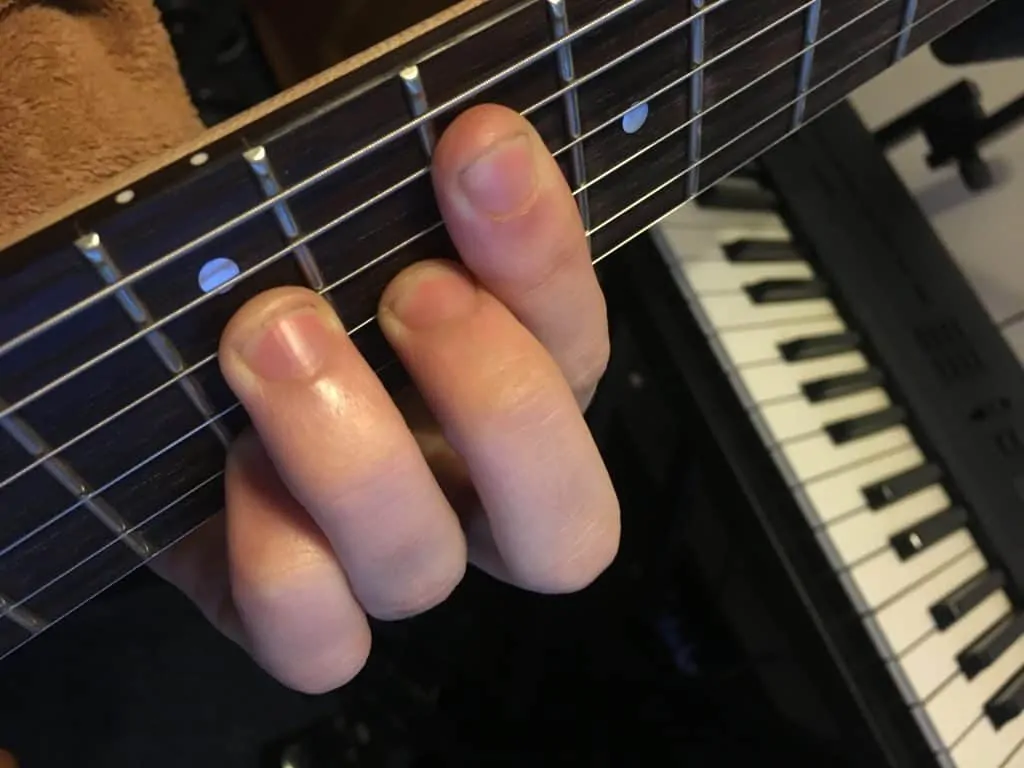
Use your 2nd finger to barre the 10th fret from the 5th-1st strings. Then use your 4th finger to press down on the 12th fret of the 4th string, your 3rd finger on the 11th fret of the 3rd string and your 5th finger on the 12th fret of the 2nd string.
Variation 2
This one takes a bit more stretching, but if you can get used to it then this voicing is another that is quite easy to move up and down the neck in order to change root notes, and gives quite a jangly, mandolin-like quality.

Use your 2nd finger to barre the 7th fret of the 1st, 2nd and 3rd strings, then your 4th finger will need to jump over to the 9th fret of the 4th string and your 5th finger to the 10th fret of the 5th string. Make sure to mute that low E string.
Variation 3
Technically, the Gmaj7 chord does have an open variant, and to look at, it is almost identical to the regular open G major chord, however, it is a lot harder to pull of comfortably.
Put your 4th finger on the 3rd fret of the 6th string, your 2nd finger on the 2nd fret of the 5th string and then try and bend your hand so that your 3rd finger can reach the 2nd fret of the 1st string. Told you it was a tough one…
Gm7 Theory
The Gm7 chord (G minor 7) is based on a minor chord with a minor 7th above. It’s sort of the sadder version of the major 7th chord, giving off more of a negative sound due to the minor 3rd, but less dissonance due to the minor 7th interval instead of the major 7th.
If we look at it using the major scale formula, then it follows a pattern of 1-b3-5-b7.
This means that the notes in a Gm7 chord are G-Bb-D-F.
Songs That Use Gm7
Gm7 is similar in its use to Gmaj7, as it can give flair and dissonance to a piece, and so lends itself nicely to pop music. Its dissonance, though, allows it to be heard in a lot of jazz music.
- The Jam- That’s Entertainment
- Soft Cell- Tainted Love
- Charlie Parker- Scrapple From The Apple
- Meghan Trainor- All About That Bass
- The Beatles- Hey Jude
- Pink Floyd- Great Gig In The Sky
Playing Gm7
Variation 1
This version of Gm7 is a nice easy one that you’ll be able to pick up pretty quick once you’ve looked at G major and G minor barre chords as the shape is roughly the same.

Barre across the 3rd fret with your 2nd finger. Then use your 4th finger to press down on the 5th fret of the 5th string. Make sure your 3rd fret on the 4th string is pressed down hard enough so that the string doesn’t get muted, as this is the minor 7th you want to be making heard.
Variation 2
This one is nice to use when playing jazz, if you play it using a shape often referred to as a bridge shape. When playing in this shape, you could pluck the strings in a jazzy way.

You could just barre the 3rd fret using your 2nd finger from string 4-1, but to make it jazzy you may want to put your 2nd finger on the 3rd fret of the 4th string, your 3rd finger on the 3rd fret of the 3rd string, your 4th finger on the 3rd fret of the 2nd string and your 5th finger on the 3rd fret of the 1st string.
Variation 3
This variation is another one high up the neck, and essentially uses a D minor shape but as it doesn’t have any open strings. Again, this one is pretty good for jazz but as its high up the neck it would be quite nice in an atmospheric, calm track.

Press your 2nd finger into the 5th fret of the 4th string, then your 5th finger into the 7th fret of the 3rd string, your 3rd finger onto the 6th fret of the 2nd string and your 4th finger onto the 6th fret of the 1st string.
Other G Chords
There are a lot of other types of chords you can use based around a G tonic. The ones I’ve shown you so far are probably the most common you’ll come across, particularly major and minor.
- G7#9 is one of my favourites, and adds a #9th (AKA the #2nd) degree of the scale to a dominant 7th chord. The formula for this one is 1-3-5-b7-#9, so the notes in the chord are G-B-D-F-A#.
- Gmaj9 is another really pleasant, calm sounding chord that adds a 9th to the maj7 chord. The formula is therefore 1-3-5-7-9 and the notes are G-B-D-F#-A.
- Gm11 skips the 9th and adds an 11th (which is essentially a 4th up an octave). The formula is 1-b3-5-b7-11 and the notes are G-Bb-D-F-C.
There are obviously a lot more chords than this, but these are a few I really like. I have a few tricks to bear in mind when working out chords yourself.
- If you’re in an alternate tuning, remember these explanations won’t be the same! Take a look at our guide to Tuning The Guitar to better understand this.
- Using a formula to work out what notes are in a chord is a really simple way to help you out.
- When building chords that are hard to voice, the 5th is the first degree of the chord you are able to drop. Never drop the root, because that will normally completely change the chord you’re playing. For example, dropping the G from a Gm7 chord just makes a Bb major…
Good Luck!

Dan is a music tutor and writer. He has played piano since he was 4, and guitar and drum kit since he was 11.
He plays a Guild acoustic and a Pacifica electric. He has been sent to many festivals and gigs (ranging from pop to extreme metal) as both a photographer and reviewer, with his proudest achievement so far being an interview he has with Steve Hackett (ex-Genesis guitarist).
He ranks among his favourite ever guitarists, alongside Guthrie Govan, Jimmy Page, Jimi Hendrix, David Gilmour and Robert Fripp. His favourite genre of music is progressive rock, which he likes to use as a reference point in my teaching, thanks to its huge complexity in structure, rhythm and harmony. However, he is also into a lot of other genres including jazz, 90’s hip-hop, death metal and 20th century classical music.

